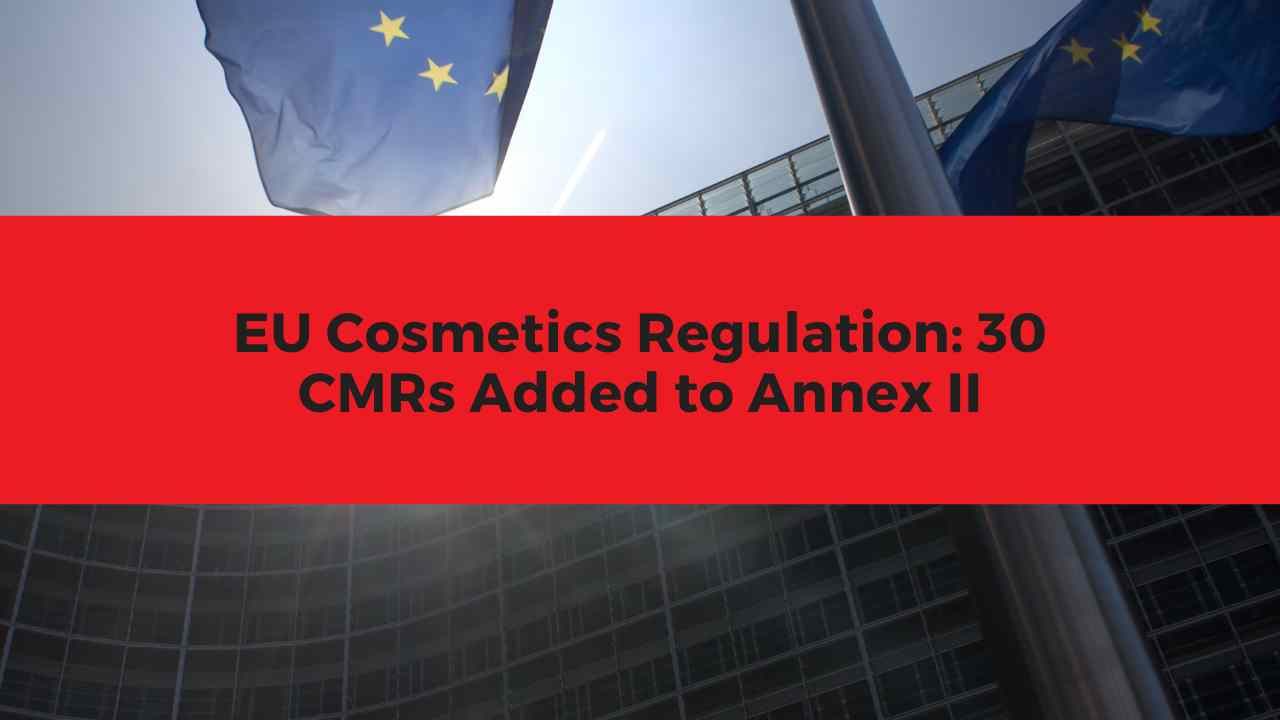The European Commission has recently introduced Regulation (EU) 2023/1490, an amendment to EU cosmetics regulation. In this blog post, we’ll break down the key points of this regulation and what it means for cosmetic manufacturers selling into the EU.
CMRs Added to the Annex II
The primary objective of the new regulation 2023/1490 is to protect consumers’ health and well-being. It targets substances classified as carcinogenic, mutagenic, or toxic for reproduction also known as CMR substances. As a result of this regulation, 30 new CMR substances will be added to the list of prohibited substances in Annex II of Regulation (EC) No 1223/2009.
The 30 New CMRs
Here is a list of the 30 CMRs added to Annex II. For the original table click here.
| Count | Chemical name/INN | CAS number |
|---|---|---|
| 1 | Ammonium bromide | 12124-97-9 |
| 2 | Dibutyltin bis(2-ethylhexanoate) | 2781-10-4 |
| 3 | Dibutyltin di(acetate) | 1067-33-0 |
| 4 | Tellurium dioxide | 7446-07-3 |
| 5 | Barium diboron tetraoxide | 13701-59-2 |
| 6 | 2,2-dimethylpropan-1-ol,tribromo derivative; 3-bromo-2,2-bis(bromomethyl)propan-1-ol | 36483-57-5/1522-92-5 |
| 7 | 2,4,6-tri-tert-butylphenol | 732-26-3 |
| 8 | 4,4’-sulphonyldiphenol; bisphenol S | 80-09-1 |
| 9 | Benzophenone | 119-61-9 |
| 10 | Quinoclamine (ISO); 2-amino-3-chloro-1,4-naphthoquinone | 2797-51-5 |
| 11 | Perfluoroheptanoic acid; tridecafluoroheptanoic acid | 375-85-9 |
| 12 | methyl N-(isopropoxycarbonyl)-L-valyl-(3RS)-3-(4-chlorophenyl)-β-alaninate; valifenalate | 283159-90-0 |
| 13 | 6-[C12-18-alkyl-(branched, unsaturated)-2,5-dioxopyrrolidin-1-yl]hexanoic acid, sodium and tris(2-hydroxyethyl)ammonium salts | – |
| 14 | 6-[(C10-C13)-alkyl-(branched, unsaturated)-2,5-dioxopyrrolidin-1-yl]hexanoic acid | 2156592-54-8 |
| 15 | 6-[C12-18-alkyl-(branched, unsaturated)-2,5-dioxopyrrolidin-1-yl]hexanoic acid | – |
| 16 | Theophylline; 1,3-dimethyl-3,7-dihydro-1H-purine-2,6-dione | 58-55-9 |
| 17 | 1,3,5-triazine-2,4,6-triamine; melamine | 108-78-1 |
| 18 | Fluopicolide (ISO); 2,6-dichloro-N-[3-chloro-5-(trifluoromethyl)-2-pyridylmethyl]benzamide | 607-285-6 |
| 19 | N-(2-nitrophenyl)phosphoric triamide | 874819-71-3 |
| 20 | N-(5-chloro-2-isopropylbenzyl)-N-cyclopropyl-3-(difluoromethyl)-5-fluoro-1-methyl-1H-pyrazole-4-carboxamide; isoflucypram | 1255734-28-1 |
| 21 | Reaction mass of 3-(difluoromethyl)-1-methyl-N-[(1RS,4SR,9RS)-1,2,3,4-tetrahydro-9-isopropyl-1,4-methanonaphthalen-5-yl]pyrazole-4-carboxamide and 3-(difluoromethyl)-1-methyl-N-[(1RS,4SR,9SR)-1,2,3,4-tetrahydro-9-isopropyl-1,4-methanonaphthalen-5-yl]pyrazole-4-carboxamide [≥ 78 % syn isomers ≤ 15 % anti isomers relative content]; isopyrazam | 881685-58-1 |
| 22 | Margosa, ext. [from the kernels of Azadirachta indica extracted with water and further processed with organic solvents] | 84696-25-3 |
| 23 | Cumene | 98-82-8 |
| 24 | 2-ethyl-2-[[(1-oxoallyl)oxy]methyl]-1,3-propanediyl diacrylate; 2,2-bis(acryloyloxymethyl)butyl acrylate; trimethylolpropane triacrylate; | 15625-89-5 |
| 25 | Pentapotassium 2,2’,2’’,2’’’,2’’’’-(ethane-1,2-diylnitrilo)pentaacetate | 7216-95-7 |
| 26 | N-carboxymethyliminobis(ethylenenitrilo)tetra(acetic acid); Pentetic Acid (INCI) | 67-43-6 |
| 27 | Pentasodium (carboxylatomethyl)iminobis(ethylenenitrilo)tetraacetate; Pentasodium Pentetate (INCI) | 140-01-2 |
| 28 | Acetamiprid (ISO); (1E)-N-[(6-chloropyridin-3-yl)methyl]-N’-cyano-N-methylethanimidamide; (E)-N1-[(6-chloro-3-pyridyl)methyl]-N2-cyano-N1-methylacetamidine | 135410-20-7/160430-64-8 |
| 29 | Pendimethalin (ISO); N-(1-ethylpropyl)-2,6-dinitro-3,4-xylidene | 40487-42-1 |
| 30 | Bentazone (ISO); 3-isopropyl-2,1,3-benzothiadiazine-4-one-2,2-dioxide | 25057-89-0 |
Effective date
This regulation applies from 1 December 2023. Cosmetics with any of the above ingredients must be removed from the market by this date.
2-ethylhexanoic acid
Not only does the regulation add 30 CMRs, it specifically addresses the substance 2-ethylhexanoic acid and its classified salts. While 2-ethylhexanoic acid is already listed in entry 1024 of Annex II, the salts of this substance were missing. To address this, the salts of 2-ethylhexanoic acid will be added to Annex II.
Compliance and Best Practices:
To ensure compliance with the new regulation, EU cosmetic manufacturers should take proactive steps:
- Review Formulations: Thoroughly assess your cosmetic product formulations to identify and eliminate any CMR substances listed above.
- Update PIFs: Check your Product Information Files (PIFs) to ensure they are in line with the revised regulations.
- Stay Informed: Keep up-to-date with any changes to EU cosmetic regulation
The new EU regulation 2023/1490, bolsters the safety of cosmetic products in the EU market. By prohibiting the use of CMR substances and amending the lists of substances, the EU aims to provide consumers with safer beauty products. Subscribe to get EU cosmetic regulatory updates.



Comments are closed here.